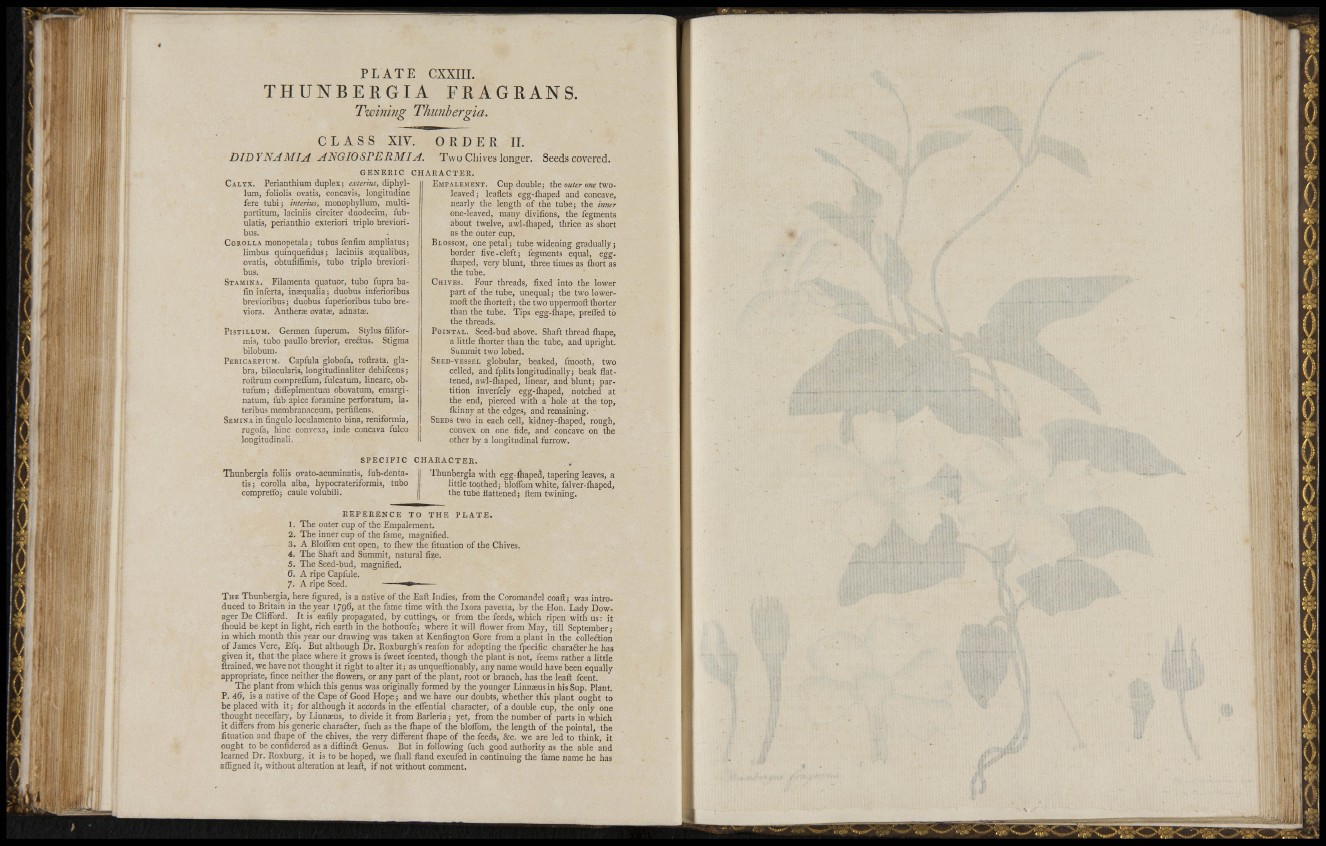
. I •
P L A T E CXXIII
T H U N B E R G I A FRAGRANS.
Twining Thimhergia.
C L A S S XIV. O RDE R IL
DIB YNAMIA AIsGIO&FERMIA. Two Chives longer. Seeds covered.
GENERIC
CALYX. Perianthiura duplex; exterius, diphyllum,
foliolis ovatis, concavis, longitudine
fere tubi ; ìnterius, monophyllum, multiparlitura,
laciniis circiter duodecim, fubulatis,
periantliio exterior! triplo brevioribus.
COROLLA monopetala; tubus fenfim ampliatus;
limbus quinquefidus; laciniis aequalibuSj
ovatis, obtufiffimis, tubo triplo brevioribus.
STAMINA. Filamenta quatuor, tubo fupra balín
inferta, inasqualia ; duobus iuferioribus
brevioribus; duobus fuperioribus tubo breviora.
Autherae ovatse, adnatae.
PisTiLLUM. Germen fuperum. Stylus filiformis,
tubo paullo brevior, ereÉtus. Stigma
bilobum.
PERICAKPIUM. Capfula globofa, roftrata, glabra,
bilocularis, longitudinaliter dehifcens ;
roftrum couiprelTum, fulcatum, lineare, obtufum;
diflepimentum obovatum, emarginatum,
lub apice foramine perforatum, lateribus
membra naceum, perfiftens.
SEMINA in fingulo loculamento bina, reniformia,
rugofa, hinc convexa, inde concava fulco
longitudinali.
CHAEACTEK.
EMPALEMENT. Cup double; the outer one twoleaved
; leaflets egg-fliaped and concave,
nearly the length of the tube; the inner
one-leaved, many divifions, the fegments
about twelve, awl-iliaped, tlirice as short
as the outer cup.
BLOSSOM, one petal ; tube widening gradually ;
border five-cleft; fegments equal, egg.
ihaped, very blunt, tliree times as lliort as
the tube.
CHIVES. Four threads, fixed into the lower
part of the tube, unequal; the two lowermoft
the iliorteft; the two uppermoft ihorter
than the tube. Tips egg-ihape, preifed to
the threads.
POINTAL. Seed-bud above. Shaft thread fliape,
a little ihorter than the tube, and upright.
Summit two lobed.
SEED-VESSEL globular, beaked, fmooth, two
celled, and fplits longitudinally; beak flattened,
awl-iliaped, linear, and blunt; partition
inverfely egg-fliaped, notched at
the end, pierced with a hole at the top,
ikinny at tlie edges, and remaining.
SEEDS two in each cell, kidney-lhaped, rough,
convex on one fide, and concave on the
other by a longitudinal furrow.
S P E C I F I C CHAKACTEIi.
Thunbergia foliis ovato-acuminatis, fub-dentatis;
corolla alba, hypocrateriformis, tubo
compreflTo; caule volubili.
Thunbergia with egg-fliaped, tapering leaves, a
little toothed; b olfom white, falver-fliaped,
the tube flattened; ftem twining.
TiEFEKENCE TO THE PLATE.
1. The outer cup of the Empalement.
2. The inner cup of the fame, magnified.
3. A BloflTom cut open, to fliew the fituation of the Chives.
4. The Shaft and Summit, natural fize.
5. The Seed-bud, magnified.
6. A ripe Capfule.
7. A ripe Seed.
THE Thunbergia, here figured, is a native of the Eaft Indies, from the Coromandel coatl:; was introduced
to Britain in the year l/g6, at the fame time with the Ixora pavetta, by the Hon. Lady Dowager
De Clifford. It is eafily propagated, by cuttings, or from the feeds, which ripen with us: it
iTiould be kept in light, rich earth in the hothoufe; where it will flower from May, till September;
in which month this year our drawing was taken at Kenfington Gore from a plant in the colleftion
of James Vere, Efq. But although Dr. Roxburgh's reafon for adopting the fpecific chara£terhe has
given it, that the place where it grows is fweet fcented, though the plant is not, feems rather a little
ftrained, we have not thought it right to alter it; as unqueftionably, any name would have been equally
appropriate, fince neither the flowers, or any part of the plant, root or branch, has the leaft fcent.
The plant from which this genus was originally formed by the younger Linnaeus in his Sup. Plant.
P. 46, is a native of the Cape of Good Hope; and we have our doubts, whether this plant ought to
be placed with it; for although it accords in the eflTential character, of a double cup, the only one
thought necefl"ai7', by Linnaeus, to divide it from Barleria ; yet, from the number of parts in which
it differs from his generic charafter, fuch as the ihape of the blofi"om, the length of the pointal, the
fituation and ihape of the chives, the very different lhape of the feeds, &c. we are led to think, it
ought to be confidered as a diftinft Genus. But in following fuch good authority as the able and
learned Dr. Roxburg, it is to be hoped, we iliall iland excufed in continuing the fame name he has
afljgned it, witliout alteration at leaft, if not without comment.
'.'li Hi
M »1
il
^ : ii
f Ì ;
hi